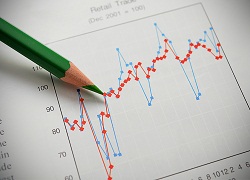 There are many contentious views with regards to trading off certain time frames. Many experienced traders will suggest that you should be able to spot price action across any time frame as it develops from its beginning, especially if you are what we often refer to as a “price action” trader.
There are many contentious views with regards to trading off certain time frames. Many experienced traders will suggest that you should be able to spot price action across any time frame as it develops from its beginning, especially if you are what we often refer to as a “price action” trader.
In theory, as a price action trader, if the market makes a dramatic move, due to a violent change in sentiment, then the evidence will eventually show on low time frames such as 5 minutes, as well as high time frames, such as 3 hour and above.
However, choosing the correct time frame becomes imperative if you’re attempting to match your trading style to the market action. For example, if you’re a day trader then trading off the daily chart will make little sense. Similarly, if you’re a swing trader looking for movement on the five minute chart, hoping that the price action will eventually move through the gears right up to the daily chart is fraught with potential failure points on each ascending time frame. Therefore it’s worth traders taking time out to determine which time frame is the most appropriate to their trading style and strategy.
Logically, if you’re a swing trader, you should be looking to trade off higher time frames, such as the 4 hour time frame, right up to the weekly time frame. If you’re a day trader you should be looking to trade off time frame such as the 15 minute up to perhaps the one hour time frame.
But is it really that simple? Well yes, actually it is (or should be) but it wouldn’t be us as traders if we didn’t look for reasons to over complicate what should in theory be a straightforward process of elimination. So let’s deal with some of the contentious views we mentioned earlier, we’ll air them without adding comment, hopefully they’ll provoke some interesting ideas in your own mind without diverting you from our intention; to find out which time frames are suited to your trading…
[quote]All we do when using time frames is measure the Open, High, Low and Close (OHLC) of x amount of time. But price is uniformly the same. All we are doing is measuring the order flow; either selling or buying and extreme points over X amount of time. Just because you are ‘zooming in or out’ of it the market doesn’t change.[/quote]
[quote]If you are looking at them right all time frames should ‘tell you’ the same thing. Time frame is just a measure of price/time = force. However, the quotes for pairs will be the same across all across the board from monthly to tick charts.[/quote]
[quote]Time frames show you different scales; this is convenient so you don’t have to remember recent price moves that may well be informative.[/quote]
[quote]It’s a matter of reference points. The market trades in only one time frame, the ‘NOW’ quotes are the reality. Time frames just measure the movement of quotes over x amount of time.[/quote]
[quote]When you trade the 5 min, the 15 min, the 1 hour and the daily they are not different markets with no correlation to each other, as many traders suggest. It is still the same currency.[/quote]
[quote]Price has no timeframe; it starts moving Monday morning and doesn’t stop until Friday evening. When you look at any timeframe lower than 1W you see a whole lot of “opens” and “closes” which aren’t really there – they are imaginary. Trying to find patterns, or deduce any meaningful information from these imaginary levels is futile, and building indicators around imaginary points is even worse.[/quote]
Anyhow, there’s the opinions we’ve gathered, and to be fair it’s hard to argue versus any of them but let’s move on, let’s simplify the process of time frame selection, especially for our novice traders this may prove to be a valuable lesson.
So you consider yourself to be a day trader...
Day traders typically will be looking to hold their trades for minutes or hours, they won’t want to hold their trades overnight, other than in very exceptional circumstances. Day traders ideally should be looking for medium to high impact news events to cause a reaction on their charts. For ease of reference we’ll suggest looking at fifteen minute charts as a minimum.
A simple suggestion as to a day trading strategy
We make no apologies for once again referring to the cluster of indicators we use in our “is the trend is your friend?” weekly advice column that we publish late Sunday evening/early Monday morning. We’d suggest using the PSAR, MACD and DMI on a fifteen minute time frame. All left on their standard settings.
We enter when the PSAR, MACD, DMI are positive and the DMI and MACD are making higher highs or lower lows in the event of a short trade. We close without fail when the PSAR reverses trend.
A simple suggestion as to a swing trading strategy
We enter when the PSAR, MACD, DMI are positive and the DMI and MACD are making higher highs or lower lows in the event of a short trade on the daily chart. We close without fail when the PSAR reverses trend. The addition we make to this trade (versus our day trading strategy) is to use the stochastic bands on an adjusted setting of 10, 10, 5. We only enter if the stochastic bands have crossed and are either some distance from the oversold or overbought area.





